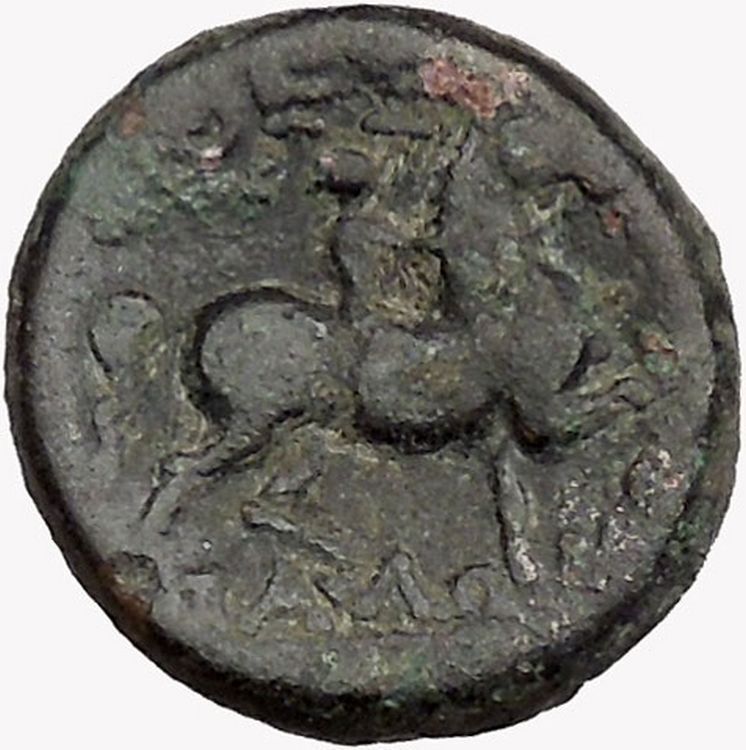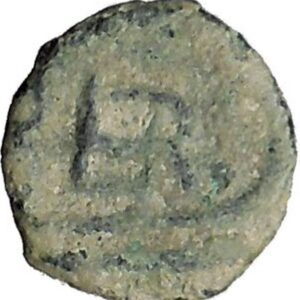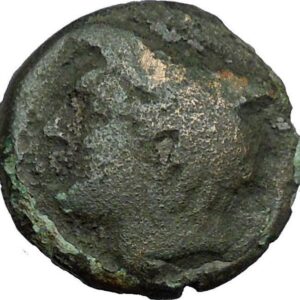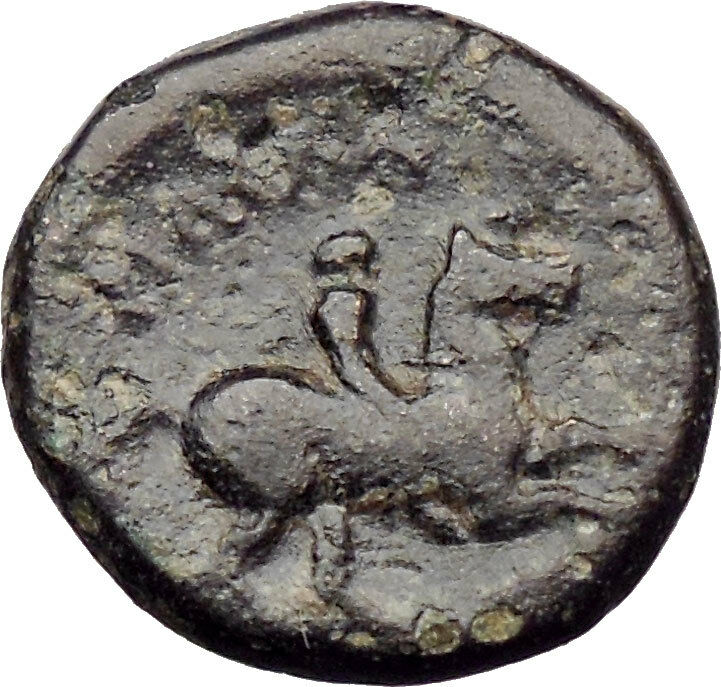To consolidate his empire and strengthen his hold over the region, Antiochus
Rebellion
|
| Power – Symbol |
Preterist view |
Historicist view |
|---|---|---|
| Great – Ram Daniel 8:4 |
Medo Persia | Medo Persia |
| Very Great – Goat Daniel 8:8 |
Greece | Greece |
| Exceeding Great – Little Horn Daniel 8:9-10 |
Antiochus IV (8th in line of 26 Seleucid Kings) | Rome |
It is important to note that the Little Horn power according to the
progression shown in Daniel 8 will have more influence and dominion than did the
Persian Empire which controlled from India to Ethiopia (Esther
1:1) and
Alexander the Great
who conquered the then
known world before the age of 32. The historical evidence shows that the
exploits of Antiochus Epiphanes is lacking in this regard.
The little horn was also to “stand up against the prince of princes”
Daniel 8:25
. That the prince of princes
represents
Jesus Christ
is of little dispute (Revelation
1:5,
Revelation 17:14
,
Revelation 19:16
). Antiochus IV died some 160
years before Jesus Christ was born. Rome, however was the dominant power that
held sway during the attempt to kill Christ as a child (Herod) and His
crucifixion (Acts
4:26-27).
That the little horn is “broken without hands” (Daniel
8:25) seems to be a reference to the events described in (Daniel
2:34) where a stone “cut out without hands” strikes the statue at the
feet representing the divided kingdoms of Rome.
Antiochus IV also paid tribute to Rome. The power that is described as
“exceeding great” would most likely be the power collecting a
tribute
rather than paying one.
A veil is an article of clothing or cloth
hanging that is intended to cover some part of the
head
or
face
, or an object
of some significance. It is especially associated
with women and sacred objects.
One view is that as a religious item, it is
intended to show honor to an object or space. The
actual sociocultural, psychological, and sociosexual
functions of veils have not been studied extensively
but most likely include the maintenance of social
distance and the communication of social status and
cultural identity. In Islamic society, various forms
of the veil have been adopted from the Arab culture
in which Islam arose. The
Quran
has no
requirement that women cover their faces with a
veil, or cover their bodies with the full-body
burqua
or
chador
.

History
The first recorded instance of veiling for women
is recorded in an
Assyrian
legal text
from the 13th century BC, which restricted its use
to noble women and forbade prostitutes and common
women from adopting it.[citation
needed] The
Mycenaean Greek
term a-pu-ko-wo-ko meaning “craftsman of
horse veil” written in
Linear B
syllabic
script is also attested since ca. 1300 BC. In
ancient Greek
the
word for veil was “καλύπτρα” (kaluptra,
Ionic Greek
“καλύπτρη” – kaluptrē, from the verb
“καλύπτω” – kaluptō, “I cover”) and is first
attested in the works of
Homer
.
Classical Greek and Hellenistic statues sometimes
depict Greek women with both their head and face
covered by a veil. Caroline Galt and Lloyd
Llewellyn-Jones have both argued from such
representations and literary references that it was
commonplace for women (at least those of higher
status) in ancient Greece to cover their hair and
face in public.
For many centuries, until around 1175,
Anglo-Saxon
and
then
Anglo-Norman
women,
with the exception of young unmarried girls, wore
veils that entirely covered their hair, and often
their necks up to their chins (see
wimple
). Only in
the
Tudor period
(1485), when
hoods
became
increasingly popular, did veils of this type become
less common.
For centuries, women have worn sheer veils, but
only under certain circumstances. Sometimes a veil
of this type was draped over and pinned to the
bonnet
or hat of a
woman in
mourning
,
especially at the
funeral
and during
the subsequent period of “high mourning”. They would
also have been used, as an alternative to a
mask
, as a simple
method of hiding the identity of a woman who was
traveling to meet a lover, or doing anything she
didn’t want other people to find out about. More
pragmatically, veils were also sometimes worn to
protect the complexion from sun and wind damage
(when un-tanned skin was fashionable), or to keep
dust out of a woman’s face, much as the
keffiyeh
is used
today.
Religion
In
Judaism
,
Christianity
and
Islam
the concept
of covering the head is or was associated with
propriety and modesty. Most traditional depictions
of the
Virgin Mary
, the
mother of
Christ
, show her
veiled. During the
Middle Ages
most
European and Byzantine married women covered their
hair rather than their face, with a variety of
styles of
wimple
, kerchiefs
and headscarfs. Veiling, covering the hair rather
than the face, was a common practice with
church-going women until the 1960s, typically using
lace
, and a number
of very traditional churches retain the custom. Lace
face-veils are still often worn by female relatives
at funerals.
In North India, Hindu women may often veil for
traditional purposes, it is often the custom in
rural areas to veil in front of male elders. This
veil is called the
Ghoonghat
or Laaj.
This is to show humility and respect to those elder
to the woman, in particular elder males. The
ghoonghat is customary especially in the westerly
states of
Gujarat
and
Rajasthan
.
Although religion stands as a commonly held
reason for choosing to veil, it has also reflects on
political regimes and personal conviction, allowing
it to serve as a medium through which personal
character can be revealed.

Tichel
Judaism
After the
destruction of the Temple
in
Jerusalem
, the
synagogues
that
were established took the design of the
Tabernacle
as their
plan. The
Ark of the Law
,
which contains the
scrolls
of the
Torah
, is covered
with an embroidered curtain or veil called a
parokhet
. (See
also
below
regarding the
veiling – and unveiling – of the bride.)
The
Veil of our Lady
is a liturgical feast celebrating the protection
afforded by the
intercessions
of
the Virgin Mary.
Traditionally, in Christianity, women were
enjoined to cover their heads in church, just as it
was (and still is) customary for men to remove their
hat as a sign of respect. This practice is based on
1 Corinthians 11:4–16
,
where
St. Paul
writes:
Any man who prays or prophesies with his head
covered brings shame upon his head. But any
woman who prays or prophesies with her head
unveiled brings shame upon her head, for it is
one and the same thing as if she had had her
head shaved. For if a woman does not have her
head veiled, she may as well have her hair cut
off. But if it is shameful for a woman to have
her hair cut off or her head shaved, then she
should wear a veil. A man, on the other hand,
should not cover his head, because he is the
image and glory of God, but woman is the glory
of man. For man did not come from woman, but
woman from man; nor was man created for woman,
but woman for man; for this reason a woman
should have a sign of authority on her head,
because of the angels. Woman is not independent
of man or man of woman in the Lord. For just as
woman came from man, so man is born of woman;
but all things are from God. Judge for
yourselves: is it proper for a woman to pray to
God with her head unveiled? Does not nature
itself teach you that if a man wears his hair
long it is a disgrace to him, whereas if a woman
has long hair it is her glory, because long hair
has been given (her) for a covering? But if
anyone is inclined to be argumentative, we do
not have such a custom, nor do the churches of
God (New
American Bible translation)
In many traditional
Eastern Orthodox Churches
,
and in some very conservative
Protestant
churches
as well, the custom continues of women covering
their heads in church (or even when praying
privately at home).
In the
Roman Catholic Church
,
it was customary in most places before the 1960s for
women to wear a headcovering in the form of a scarf,
cap, veil or hat when entering a church. The
practice now continues where it is seen as a matter
of etiquette, courtesy, tradition or fashionable
elegance rather than strictly of canon law.
Traditionalist Catholics
also maintain the practice.
The wearing of a headcovering was for the first
time mandated as a universal rule for the
Latin Rite
by the
Code of Canon Law of 1917
,
which code was abrogated by the advent of the
present (1983) Code of Canon Law. Traditionalist
Catholics majorly still follow it, generally as a
matter of ancient custom and biblically approved
aptness, some also supposing St. Paul’s directive in
full force today as an ordinance of its own right,
without a canon law rule enforcing it. The
photograph here of Mass in the
Netherlands
in
about 1946, two decades before the changes that
followed the
Second Vatican Council
,
shows that, even at that time, when a hat was still
considered part of formal dress for both women and
men, wearing a headcovering at Mass was not a
universal practice for Catholic women.
A veil over the hair rather than the face forms
part of the headdress of some
religiouss
of
nuns
or
religious
sisters;
this is why a woman who becomes a nun is said “to
take the veil”. In medieval times married women
normally covered their hair outside the house, and
nun’s veils are based on secular medieval styles,
reflecting nuns position as “brides of Christ”. In
many institutes, a white veil is used as the “veil
of probation” during
novitiate
, and a
dark veil for the “veil of profession” once
religious vows are taken – the color scheme varies
with the color scheme of the habit of the order. A
veil of
consecration
,
longer and fuller, is used by some orders for final
profession of
solemn vows
.

also wear veils
Nuns are the female counterparts of
monks
, and many
monastic orders
of
women have retained the veil. Regarding other
institutes of religious sisters who are not
cloistered
but who
work as teachers, nurses or in other “active”
apostolates outside of a nunnery or monastery, some
wear the veil, while some others have abolished the
use of the veil, a few never had a veil to start
with, but used a bonnet-style headdress even a
century ago, as in the case of
St. Elizabeth Ann Seton
.
The fullest versions of the nun’s veil cover the
top of the head and flow down around and over the
shoulders. In Western Christianity, it does not wrap
around the neck or face. In those orders that retain
one, the starched white covering about the face neck
and shoulders is known as a
wimple
and is a
separate garment.
The Catholic Church has revived the ancient
practice of allowing women to profess a solemn vow
as
consecrated virgins
.
These women are set aside as sacred persons who
belong only to Christ and the service of the church.
They are under the direct care of the local
bishop
, without
belonging to a particular order and receive the veil
as a
sign
of
consecration
.
There has also been renewed interest in the last
half century in the ancient practice of women and
men dedicating themselves as
anchorites
or
hermits
, and there
is a formal process whereby such persons can seek
recognition of their vows by the local bishop – a
veil for these women would also be traditional.
Some
Anglican
women’s
religious orders also wear a veil, differing
according to the traditions of each order.
In
Eastern Orthodoxy
and in the
Eastern Rites
of
the Catholic Church, a veil called an
epanokamelavkion
is used by both nuns and monks, in both cases
covering completely the
kamilavkion
, a
cylindrical hat they both wear. In
Slavic
practice,
when the veil is worn over the hat, the entire
headdress
is
referred to as a
klobuk
. Nuns
wear an additional veil under the klobuk,
called an
apostolnik
,
which is drawn together to cover the neck and
shoulders as well as their heads, leaving the face
itself open.
Islam
A variety of headdresses worn by
Muslim women
and
girls in accordance with
hijab
(the
principle of dressing modestly) are sometimes
referred to as veils. The principal aim of the
Muslim veil is to hide that which men find sexually
attractive. Many of these garments cover the hair,
ears and throat, but do not cover the face. The
khimar
is a
type of
headscarf
. The
niqāb
and
burqa
are two
kinds of veils that cover most of the face except
for a slit or hole for the eyes.
The
Afghan
burqa covers
the entire body, obscuring the face completely,
except for a grille or netting over the eyes to
allow the wearer to see. The
boshiya
is a
veil that may be worn over a headscarf; it covers
the entire face and is made of a sheer fabric so the
wearer is able to see through it. It has been
suggested that
the practice of wearing a veil
–
uncommon among the
Arab
tribes prior
to the rise of
Islam
– originated
in the
Byzantine Empire
,
and then spread.
The wearing of head and especially face coverings
by Muslim women has raised political issues in the
West; see for example
Hijab controversy in Quebec
,
Islamic dress controversy in
Europe
,
Islamic scarf controversy in
France
, and
United Kingdom debate over
veils
. There is also high debate of the
veil in
Turkey
, a
Muslim majority country
but secular, which banned the headscarves in
universities and government buildings, due to the
türban (a Turkish styled headscarf) being viewed as
a political symbol of Islam
,
see
Headscarf controversy in
Turkey
.

wearing a veil after the death of U.S.
President
Franklin D.
Roosevelt
Hats
Veils pinned to hats have survived the changing
fashions of the centuries and are still common today
on formal occasions that require women to wear a
hat. However, these veils are generally made of
netting or another material not actually designed to
hide the face from view, even if the veil can be
pulled down.
Wedding veils
An occasion on which a Western woman is likely to
wear a veil is on her
white wedding
day.
Brides
once used to
wear their hair flowing down their back at their
wedding to symbolise their virginity. Veils covering
the hair and face became a symbolic reference to the
virginity of the bride thereafter. Often in modern
weddings, the ceremony of removing a face veil after
the wedding to present the groom with a virgin bride
is skipped, since many couples have already entered
into conjugal relations prior to their wedding day –
the bride either wears no face veil, or it is lifted
before the ceremony begins, but this is not always
the case. Further, if a bride is a virgin, she often
wears the face veil through the ceremony, and then
either her father lifts the veil, presenting the
bride to her groom, or the groom lifts the veil to
symbolically consummate the marriage, which will
later become literal. Brides who are virgins may
make use of the veil to symbolize and emphasize
their status of purity during their wedding however,
and if they do, the lifting of the veil may be
ceremonially recognized as the crowning event of the
wedding, when the beauty of the bride is finally
revealed to the groom and the guests. It is not
altogether clear that the wedding veil is a
non-religious use of this item, since weddings have
almost always had religious underpinnings,
especially in the West. Veils, however, had been
used in the West for weddings long before this.
Roman brides, for instance, wore an intensely
flame-colored and fulsome veil, called the
flammeum, apparently intended to protect the
bride from
evil spirits
on her
wedding day. Later, the so-called velatio virginum
became part of the rite of the
consecration of virgins
,
the liturgical rite in which the church sets aside
the virgin as a sacred person who belongs only to
Christ.
In the 19th century, wedding veils came to
symbolize the woman’s
virginity
and
modesty
. The
tradition of a veiled bride’s face continues even
today wherein, a virgin bride, especially in
Christian or Jewish culture, enters the marriage
ritual with a veiled face and head, and remains
fully veiled, both head and face, until the ceremony
concludes. After the full conclusion of the wedding
ceremony, either the bride’s father lifts the veil
giving the bride to the groom who then kisses her,
or the new groom lifts her face veil in order to
kiss her, which symbolizes the groom’s right to
enter into conjugal relations with his bride.
The lifting of the veil was often a part of
ancient wedding ritual, symbolizing the
groom
taking
possession of the wife, either as lover or as
property, or the revelation of the bride by her
parents to the groom for his approval.
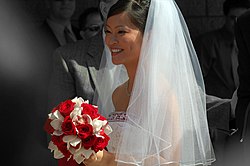
In Judaism, the tradition of wearing a veil dates
back to biblical times. According to the Torah in
Genesis 24:65
,
Isaac is brought Rebekah to marry by his father
Abraham’s servant. It is important to note that
Rebekah did not veil herself when traveling with her
lady attendants and Abraham’s servant and his men to
meet Isaac, but she only did so when Isaac was
approaching. Just before the wedding ceremony the
badeken
or bedeken
is held. The groom places the veil over the bride’s
face, and either he or the officiating Rabbi gives
her a blessing. The veil stays on her face until
just before the end of the wedding ceremony – when
they are legally married according to Jewish law –
then the groom helps lift the veil from off her
face.
The most often cited interpretation for the
badeken
is that,
according to
Genesis 29
, when
Jacob went to marry Rachel, his father in law Laban
tricked him into marrying Leah, Rachel’s older and
homlier sister. Many say that the veiling ceremony
takes place to make sure that the groom is marrying
the right bride. Some say that as the groom places
the veil over his bride, he makes an implicit
promise to clothe and protect her. Finally, by
covering her face, the groom recognizes that he his
marrying the bride for her inner beauty; while looks
will fade with time, his love will be everlasting.
In some ultra-orthodox traditions the bride wears an
opaque veil as she is escorted down the aisle to
meet her groom. This shows her complete willingness
to enter into the marriage and her absolute trust
that she is marrying the right man. In Judaism, a
wedding is not considered valid unless the bride
willingly consents to it.
In ancient
Judaism
the lifting
of the veil took place just prior to the
consummation of the marriage in sexual union. The
uncovering or unveiling that takes place in the
wedding ceremony
is
a symbol of what will take place in the marriage
bed. Just as the two become one through their words
spoken in wedding vows, so these words are a sign of
the physical oneness that they will consummate later
on. The lifting of the veil is a symbol and an
anticipation of this.
In the
Western world
,
St. Paul’s
words
concerning how marriage symbolizes the union of
Christ and His Church may underlie part of the
tradition of veiling in the marriage ceremony.
Dance
Veils are part of the stereotypical images of
courtesans and harem women. Here, the mysterious
veil hints at sensuality, an example being the dance
of the seven veils. This is the context into which
belly dancing veils fall, with a large repertoire of
ways to wear and hold the veil, framing the body and
accentuating movements. Dancing veils can be as
small as a scarf or two, silk veils mounted on fans,
a half circle, three-quarter circle, full circle, a
rectangle up to four feet long, and as large as huge
Isis wings with sticks for extensions. There is also
a giant canopy type veil used by a group of dancers.
Veils are made of rayon, silk, polyester, mylar and
other fabrics (never wool, though). Rarely used in
Egyptian cabaret style, veil dancing has always
played an important part in the international world
of belly dance, extending the range of the dance and
offering lovely transitory imagery.
Courtesans
Conversely, veils are often part of the
stereotypical image of the
courtesan
and
harem
woman. Here,
rather than the virginity of the bride’s veil,
modesty of the Muslim scarf or the piety of the
nun’s headdress, the mysterious veil hints at
sensuality and the unknown. An example of the veil’s
erotic potential is the
dance of the seven veils
.
In this context, the term may refer to a piece of
sheer cloth approximately 3 x 1.5 metres, sometimes
trimmed with sequins or coins, which is used in
various styles of
belly dancing
. A
large repertoire of ways to wear and hold the veil
exists, many of which are intended to frame the body
from the perspective of the audience.
Veils for men
Among the
Tuareg
,
Songhai
,
Moors
,
Hausa
. and
Fulani
of
West Africa
, women
do not traditionally wear the veil, while men do.
The men’s facial covering originates from the belief
that such action wards off evil spirits, but most
probably relates to protection against the harsh
desert sands as well; in any event, it is a firmly
established tradition. Men begin wearing a veil at
age 25 which conceals their entire face excluding
their eyes. This veil is never removed, even in
front of family members.
In
India
,
Pakistan
,
Bangladesh
, and
Nepal
, men wear a
sehra
on their
wedding day. This is a male veil covering the whole
face and neck. The sehra is made from either
flowers, beads, tinsel, dry leaves, or coconuts. The
most common sehra is made from fresh marigolds. The
groom wears this throughout the day concealing his
face even during the wedding ceremony. In India
today you can see the groom arriving on a horse with
the sehra wrapped around his head.
Etymology
“Veil” came from
Latin
vēlum,
which also means “sail“.
There are two theories about the origin of the word
vēlum:-
- Via the “covering” meaning, from (Indo-European
root
) *wel–
= “to cover, to enclose”. - Via the “sail” meaning, from Indo-European *weghslom,
from root *wegh- = “way” or “carry in a
vehicle”, because it makes the ship move.
|
|
|
Frequently Asked Questions How long until my order is shipped?: shipment of your order after the receipt of payment. How will I know when the order was shipped?: date should be used as a basis of estimating an arrival date. After you shipped the order, how long will the mail take? international shipping times cannot be estimated as they vary from country to country. I am not responsible for any USPS delivery delays, especially for an international package. What is a certificate of authenticity and what guarantees do you give that the item is authentic? and a Lifetime Guarantee of Authenticity, issued by a world-renowned numismatic and antique expert that has identified over 10000 ancient coins and has provided them with the same guarantee. You will be quite happy with what you get with the COA; a professional presentation of the coin, with all of the relevant information and a picture of the coin you saw in the listing. Compared to other certification companies, the certificate of authenticity is a $25-50 value. So buy a coin today and own a piece of history, guaranteed. Is there a money back guarantee? I offer a 30 day unconditional money back guarantee. I stand behind my coins and would be willing to exchange your order for either store credit towards other coins, or refund, minus shipping expenses, within 30 days from the receipt of your order. My goal is to have the returning customers for a lifetime, and I am so sure in my coins, their authenticity, numismatic value and beauty, I can offer such a guarantee. Is there a number I can call you with questions about my order?
You can contact me directly via ask seller a question and request my telephone number, or go to my About Me Page to get my contact information only in regards to items purchased on eBay. When should I leave feedback? order, please leave a positive. Please don’t leave any negative feedbacks, as it happens many times that people rush to leave feedback before letting sufficient time for the order to arrive. Also, if you sent an email, make sure to check for my reply in your messages before claiming that you didn’t receive a response. The matter of fact is that any issues can be resolved, as reputation is most important to me. My goal is to provide superior products and quality of service. |




 Antiochus IV Epiphanes (“Manifest (God)“, “the Illustrious”
Antiochus IV Epiphanes (“Manifest (God)“, “the Illustrious”